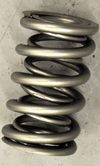Valve springs for NASCAR regional racing open engines
 Garrett Jacobson Motorsports in Northridge, California, is a full service engine-building 'shop that is in the midst of constructing a former Roush Yates Engines Ford C-3 V8 for use in its regional K&N Series NASCAR West series on the West Coast of the US.
Garrett Jacobson Motorsports in Northridge, California, is a full service engine-building 'shop that is in the midst of constructing a former Roush Yates Engines Ford C-3 V8 for use in its regional K&N Series NASCAR West series on the West Coast of the US.
The K&N Series travels to circuits around the coastal area and, like many in the NASCAR regional fold, accepts both 'spec' (crate) and 'open' engines for competition. In trying to lead competitors to the crate small-block, NASCAR has made it difficult for engine builders to be creative when using 'trickle-down' engines such as the Ford C-3, used in Nationwide Series competition nearly a decade ago.
According to Garrett Jacobson's chief operating officer Gregg Jacobson, his valve spring of choice in a very complex valvetrain system has been a double spring provided by PSI Springs; he's been working with the company for about five years, he says.
Jacobson specifies double springs of tool steel in light of the duration of valve opening, valve lift and acceleration. "We also take into consideration the size of the base circle and the stability of the lobe," he says.
In the build-up of the Ford C-3, Garrett Jacobson Motorsports carries out extensive testing of the valvetrain "to ensure that the system does not fail". Reliability is key, he says, particularly with teams that are on the road for long durations and not always able to return an engine for examination at the specified time of 800 track miles. K&N Series races can last anywhere from 50 laps to as many as 200 laps, and are held on both short and longer oval circuits.
While Jacobson does specify the particular part he wishes to use in the Ford C-3, he notes that the "spring manufacturer does an exceptional amount of research and development on their own on our behalf. That being said, it's still up to us to make the final determination that the spring we specify has to be stable on our cam profile." He makes this determination with in-house dynamometer and Spintron testing to confirm compatibility of the valve spring provided to him.
The double valve spring used in this particular application is not a bespoke unit. "PSI has been working with NASCAR race teams for a long time," Jacobson says. "This is to our advantage, because they have done the research and development on similar applications [before Jacobson's build-up of the Ford C-3]. There is no reason for us to reinvent the wheel in this particular case."
Jacobson says he takes the data from his own in-house testing and crosses it with PSI's "so we can come up with a viable part that will do a reasonable job for our engine project. If we come up with an issue during our own r&d process, we can always get in touch with the tech team at PSI to help us come up with a viable solution."
In the interest of building his Ford C-3 engine to compete against the crate engines, Jacobson says, "We do as much development work as we want to within this class. We are always looking for that competitive edge." While he may be a bit constrained by the rules and limits set by NASCAR, he says, "We can do what we want - as long as we stay within the limits they set for us."
Fig. 1 - The PSI double valve spring is a joint venture between the manufacturer and engine builder as they work to come up with the best compromise in a highly stressed engine (Photo: Anne Proffit)
Written by Anne Proffit